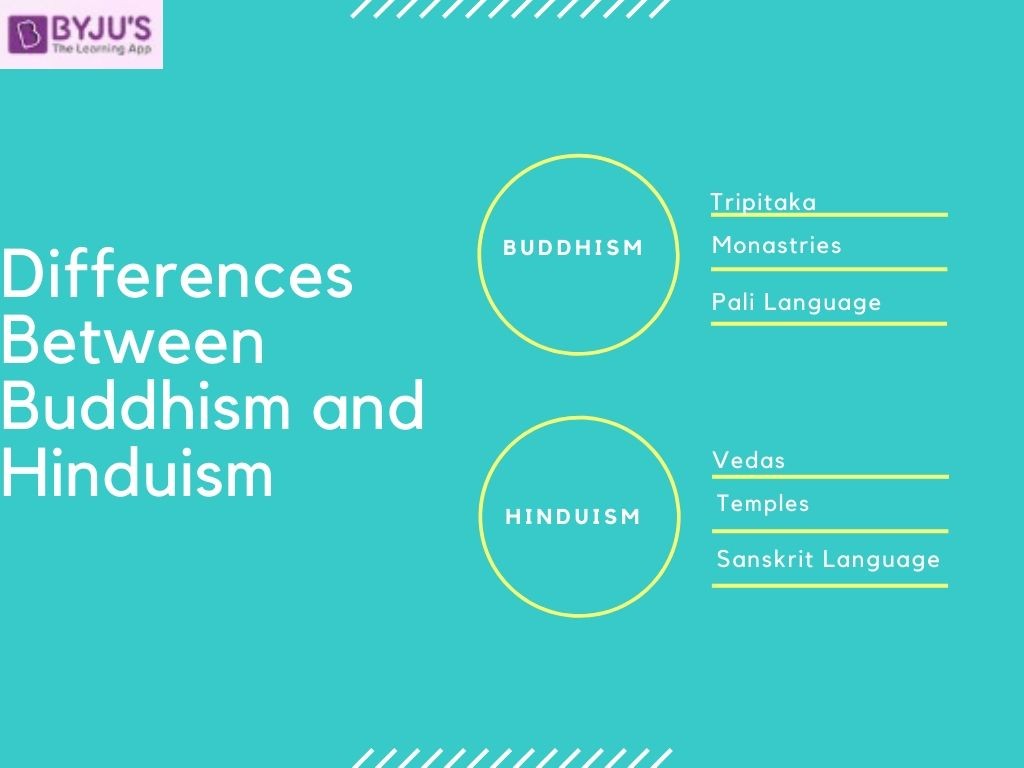Buddhism and Hinduism, two of the world’s major religions, share ancient roots in the Indian subcontinent, yet have diverged significantly in their doctrines, practices, and philosophical underpinnings. Understanding the nuances of each faith requires a careful examination of their distinctive features alongside their shared heritage. This article aims to Compare And Contrast Buddhism And Hinduism, highlighting the key differences and surprising similarities that define these spiritual traditions.
 Statue depicting differences between Buddhism and Hinduism
Statue depicting differences between Buddhism and Hinduism
While both religions emphasize spiritual awakening and ethical living, their paths to these goals differ considerably. Let’s delve into a detailed comparison to illuminate these distinctions.
Core Differences Between Buddhism and Hinduism
| Aspect | Buddhism | Hinduism |
|---|---|---|
| Followers | Buddhists | Hindus |
| Global Presence | Fourth largest religion (approx. 520 million followers, 7% of global population) | Third largest religion (approx. 1.25 billion followers, 16% of global population) |
| Place of Worship | Buddhist monasteries, shrines, temples, stupas | Temples, home shrines |
| Founder | Siddhartha Gautama (the Buddha) | No single founder; evolved over centuries with diverse traditions |
| Spiritual Leadership | In Tibetan Buddhism, the Dalai Lama is the foremost spiritual leader (Gelug school) | No single foremost spiritual leader; diverse gurus, swamis, and religious authorities |
| Monastic Community | Sangha; monks (Bhikkhus) and nuns (Bhikkhunis) | Various monastic orders; monks (Yogis, Sages, Rishis, Gurus, Priests) and nuns (Sanyasini, Sadhvi, Swamini) |
| Major Branches | Theravada, Mahayana, Vajrayana | Vaishnavism, Shaivism, Shaktism, Smartism |
| Primary Language | Pali (Theravada), Sanskrit (Mahayana, Vajrayana) | Sanskrit (primary sacred language) |
| Key Festivals | Vesak (Buddha’s Birthday), Parinirvana Day, Buddha Purnima, Ullambana, Losar | Diwali, Holi, Navaratri, Durga Puja, Ganesh Chaturthi, Mahashivaratri, Ram Navami, Krishna Janmashtami |
| Important Scriptures | Tripitaka (Pali Canon), Gandhara Texts, Sutras (Mahayana) | Vedas, Upanishads, Bhagavad Gita, Ramayana, Puranas, Mahabharata |
| Significant Symbols | Dharmachakra (Wheel of Dharma), Lotus, Conch Shell, Endless Knot, Victory Banner, Golden Fish, Parasol, Vase | Om, Swastika, Shiva Linga, Sri Yantra |
| Marriage | Not a religious duty; monastic celibacy is highly valued | Considered a religious duty and sacrament; various perspectives on marriage within Hinduism |
| Concept of Sin | Absence of a formal concept of sin; focus on karma and negative actions | Sin exists; actions have karmic consequences; repentance for unintentional sins is possible |
| Origins | India, 6th century BCE (Buddha’s enlightenment) | Indian subcontinent, pre-3000 BCE (Vedic period and earlier) |
| Vedas | Rejected the authority of the Vedas | Vedas are considered sacred and foundational scriptures |
| Ultimate Goal | Nirvana (liberation from suffering and the cycle of rebirth), lasting happiness | Moksha (liberation from the cycle of birth and rebirth), union with the divine |
| Geographical Distribution | Predominantly in Asian countries (India, Nepal, Sri Lanka, Thailand, Japan, Myanmar, Bhutan, etc.) | Primarily in India, Nepal, and among diaspora communities worldwide (Bali, Mauritius, Caribbean, North America) |
| Path to Enlightenment | Noble Eightfold Path (right understanding, thought, speech, action, livelihood, effort, mindfulness, concentration) | Multiple paths (Yoga): Karma Yoga (path of action), Bhakti Yoga (path of devotion), Jnana Yoga (path of knowledge) |
| Concept of Self (Atman) | Anatman (no-self); denies the existence of a permanent, unchanging self or soul | Atman (soul or self) is considered eternal and part of Brahman (ultimate reality) |
| God/Deity Concept | Non-theistic in Theravada; Mahayana Buddhism includes Bodhisattvas and celestial Buddhas | Polytheistic with a vast pantheon of gods and goddesses, often seen as manifestations of a supreme being (Brahman or others depending on denomination) |
| Social Structure | Rejected the caste system | Historically associated with the caste system (though interpretations and practices vary widely today) |
Delving Deeper into Key Differences
Founder and Historical Context: Buddhism is attributed to a single historical figure, Siddhartha Gautama, who became the Buddha after attaining enlightenment. His teachings, developed in the 6th century BCE, formed the basis of Buddhism. Hinduism, however, lacks a single founder. It evolved organically over millennia, drawing from diverse traditions, philosophies, and scriptures of ancient India. Its roots can be traced back to the Indus Valley Civilization and Vedic period, long before the emergence of Buddhism.
Concept of Self and Ultimate Reality: A fundamental difference lies in the concept of “self” or soul. Buddhism propounds the doctrine of Anatman, meaning “no-self.” It asserts that there is no permanent, unchanging self or soul within individuals. Instead, what we perceive as “self” is a collection of constantly changing physical and mental processes. Hinduism, conversely, believes in Atman, the individual soul, which is considered eternal, indestructible, and ultimately part of Brahman, the ultimate, unchanging reality or cosmic consciousness. The goal in Hinduism is often seen as realizing the unity of Atman with Brahman.
Path to Liberation: Buddhism emphasizes the Noble Eightfold Path as the way to achieve Nirvana, the cessation of suffering and liberation from the cycle of rebirth. This path encompasses ethical conduct, mental discipline, and wisdom. Hinduism offers multiple paths or Yogas to achieve Moksha, liberation from the cycle of birth and death and union with the divine. These paths include Karma Yoga (path of selfless action), Bhakti Yoga (path of devotion to a deity), and Jnana Yoga (path of knowledge and wisdom).
God and Deities: In its original Theravada form, Buddhism is often considered non-theistic. While it acknowledges deities, they are not seen as creators or controllers of the universe, nor are they central to the path to enlightenment. Mahayana Buddhism, which developed later, incorporates Bodhisattvas (enlightened beings who postpone Nirvana to help others) and celestial Buddhas, which are venerated. Hinduism is characterized by a vast pantheon of gods and goddesses. While often described as polytheistic, many Hindus believe in a supreme, ultimate reality (Brahman) that manifests in various deities. Different denominations within Hinduism may prioritize different deities as the supreme form of the divine.
Social Structure and Caste System: Buddhism, from its inception, rejected the rigid social hierarchy of the caste system prevalent in ancient India. Buddha’s teachings were open to all, regardless of social standing. Hinduism, historically, has been associated with the caste system, a hierarchical social structure that divided society into classes based on birth. While the caste system is officially outlawed in modern India and its influence has diminished, its historical and social impact on Hinduism is undeniable, though contemporary Hindu thought and reform movements actively challenge caste discrimination.
Striking Similarities Between Buddhism and Hinduism
Despite their significant differences, Buddhism and Hinduism also share notable common ground:
-
Origins in India: Both religions originated in the Indian subcontinent, sharing a cultural and philosophical milieu. This shared origin is evident in some overlapping concepts and terminology.
-
Concepts of Karma and Reincarnation: Both religions accept the doctrines of karma and reincarnation (samsara). Karma refers to the principle of cause and effect, where actions have consequences that shape future lives. Reincarnation is the cycle of birth, death, and rebirth, driven by karma. Both religions see liberation from this cycle as a primary spiritual goal, though they define the nature of liberation differently (Nirvana vs. Moksha).
-
Emphasis on Dharma and Ethical Living: Dharma (righteous conduct, duty) is a central concept in both traditions. Both Buddhism and Hinduism emphasize ethical living, compassion, non-violence (Ahimsa), truthfulness, and self-discipline as essential for spiritual progress.
-
Meditation and Contemplative Practices: Meditation and various contemplative practices are integral to both Buddhism and Hinduism. These practices are used to cultivate mindfulness, concentration, and inner peace, leading to spiritual insight and transformation.
-
Spiritual Liberation as the Ultimate Goal: Both religions consider spiritual liberation as the ultimate aim of human existence. While they may differ in their definitions of this liberation (Nirvana or Moksha), both paths aim to transcend the limitations of ordinary existence and attain a state of enlightenment or union with the divine.
-
Idol Worship (in some traditions): While Theravada Buddhism is generally non-idolatrous, Mahayana Buddhism incorporates idol worship, with images of Buddha and Bodhisattvas venerated in temples and homes. Idol worship is a significant aspect of Hindu practice, with deities represented through murtis (images) in temples and home shrines.
-
Gender Equality (in principle): In principle, both religions advocate for gender equality in spiritual practice. While historical and social realities may have presented challenges to women’s full participation, both traditions, in their core teachings, do not inherently discriminate against women in their capacity for spiritual attainment.
-
Acceptance of Atheists in Religious Activities: Within certain interpretations and communities in both religions, there is a degree of acceptance for atheists or those with differing beliefs to participate in cultural or community aspects of religious life.
Conclusion: Two Paths from a Shared Root
Comparing and contrasting Buddhism and Hinduism reveals a fascinating interplay of divergence and convergence. While they emerged from a shared spiritual and cultural landscape in ancient India and retain certain commonalities like karma, reincarnation, and ethical principles, they offer distinct paths to spiritual liberation. Buddhism, with its emphasis on the Eightfold Path, Anatman, and Nirvana, presents a unique approach focusing on self-reliance and the cessation of suffering. Hinduism, with its rich pantheon of deities, diverse yogic paths, and the concept of Atman-Brahman unity, offers a multifaceted tradition rooted in ancient scriptures and evolving philosophical interpretations. Understanding both their differences and similarities provides valuable insights into the rich tapestry of Indian spirituality and the diverse ways humans seek meaning and transcendence.
